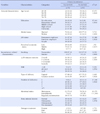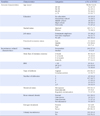Abstract
Purpose
The purpose of this study was to identify the current urinary incontinence states in women above middle age dwelling in rural areas and their coping with the problems.
Methods
The participants were 261 women above middle age. Data were collected from February to May, 2012 using a structured questionnaire. The data were analyzed with the SPSS/WIN 20 program.
Results
The frequency of urinary incontinence in women above middle age was 45.4%. There were significant differences in urinary incontinence due to age, education, job status, frequency of delivery, and menstrual status. And, there were significant relations among urinary symptoms, difficulty of ADL, incontinence stress and depression. Frequently used coping-methods with urinary incontinence were washing frequently in order to avoid awful smell, paying attention to perineal cleaning, and going to restroom frequently.
Figures and Tables
Table 2
Differences in Urinary Incontinence according to General & Incontinence related Characteristics

References
1. Butler RN, Maby JI, Montella JM, Young GP. Urinary incontinence: Primary care therapies for the older woman. Geriatrics. 1999; 54(11):31–34.
2. Chae MJ, So HS, Lee JS, Lee SY, Lee JH, Lim JI. Urinary incontinence and quality of life among middle- aged women in community. Chonnam J Nurs Sci. 2009; 14(1):81–95.
3. Cho GY, Park JS. A study on the characteristics of urinary incontinence, related problems and management in elderly women in nursing homes. J Korean Gerontol Nurs. 2009; 11(2):162–172.
4. Coyne KS, Kvasz M, Ireland AM, Milson I, Kopp ZS, Chapple CR. Urinary incontinence and its relationship to mental health and health-related quality of life in men and women in Sweden, the United Kingdom, and United States. Eur Urol. 2012; 61(1):88–95.
5. Diokno AC, Estanol MV, Mallet V. Epidemiology of lower urinary tract dysfunction. Clin Obstet Gynecol. 2004; 47(1):36–43.

6. Dugan E, Roberts CP, Cohen SJ, Preisser JS, Davis CC, Bland DR, et al. Why older community-dwelling adults do not discuss urinary incontinence with their primary care physicians. J Am Geriatr Soc. 2001; 49(4):462–465.

7. Fultz NH, Herzog AR. Self-reported social and emotional impact of urinary incontinence. J Am Geriatr Soc. 2001; 49(7):892–899.

8. Gasquet I, Tcherny-Lessenot S, Gaudebout P, Goux BB, Klein P. Influence of the severity of stress incontinence on quality of life, health care seeking and treatment: A national cross sectional study. Eur Urol. 2006; 50(4):818–825.
9. Hannestad YS, Rertveit S, Dalveit AJ, Hunskaar S. Are smoking and other lifestyle factors associated with female urinary incontinence? The Norwegian EPINCONT study. BJOG. 2003; 110(3):247–254.

10. Kee BS. A preliminary study for the standardization of geriatric depression scale short form-Korean version. J Korean Neuropsychiatr Assoc. 1996; 35(2):298–307.
11. Kim DS, Lim HS, Kim DH. A study on the health promotion behaviors in rural areas. J Agric Med Community Health. 2000; 25(2):327–341.
12. Kim JI. The evaluation of 10 week urinary tract function promotion program for the elderly women in the community. Korean J Women Health Nurs. 2003; 9(4):439–448.

13. Kim KH. Study on correlation between urinary incontinence & lower urinary tract symptom and daily life of middle- aged & elderly women in urban city. Seoul: Ewha Womans University;2002. Unpublished master's thesis.
14. Lee JS. A study on daily life inconvenience and quality of life related to urinary incontience in the elderly women using the welfare center. Gwangju: Chonnam National University;2008. Unpublished master's thesis.
15. Lee KS, Sung HH, Na S, Choo MS. Prevalence of urinary incontinence in Korean women: Results of a national health interview survey. World J Urol. 2008; 26(2):179–185.

16. Lionis C, Vlachonikolis L, Bathianaki M, Daskalopoulos G, Anifantaki S, Cranidis A. Urinary incontinence, the hidden health problem of Cretan women: Report from a primary care survey in Greece. Women Health. 2000; 31(4):59–66.

17. Oh HS, Kim MK. Factors affecting the severity of urinary incontinence and the quality of life of Women with urinary incontinence. J Korean Acad Nurs. 2005; 35(3):469–477.

18. Oh SJ, Hong SK, Son HC, Paick JE, Ku JH. Quality of life and disease severity in Korean women with stress urinary incontinence. Urology. 2005; 66(1):69–73.

19. Oh SJ, Park HG, Paick SH, Park WH, Choo MS. Translation and linguistic validation of Korean version of the Bristol female lower urinary tract symptom instrument. J Korean Continence Soc. 2004; 8(2):89–113.

20. Palmer MH, Fitzgerald S. Urinary incontinence in working women: A comparison study. J Womens Health (Larchmt). 2002; 11(10):879–888.

21. Parazzini F, Chiaffarino F, Lavezzari M, Giambanco V. Risk factors for stress, urge or mixed urinary incontinence in Italy. BJOG. 2003; 110(10):927–933.

22. Park OH, Kwon IS, Kang YS. A study on urinary incontinence of elderly women in a community. J Korean Acad Womens Health Nurs. 2001; 7(4):536–546.

23. Rortveit G, Hannestad YS, Dalveit AJ, Hunskaar S. Age-and type-dependent effects of parity on urinary incontinence: The Norwegian EPINCONT study. Obstet Gynecol. 2001; 98(6):1004–1010.
24. Sheikh JI, Yesavage JA. Geriatric depression scale (GDS): Recent evidence and development of a short version. Clin Gerontol. 1986; 5(1-2):165–172.
25. Shin KR, Kang YH, Oak JW. The relationship of quality of sleep, depression, late-life function and disability in community-dwelling older women with urinary incontinence. J Korean Acad Nurs. 2008; 38(4):573–581.
26. Sims J, Browning C, Lindquist BL, Kendig H. Urinary incontinence in a community sample of older adults: prevalence and impact on quality of life. Disabil Rehabil. 2011; 33(15-16):1389–1398.

27. Song YS, Son YJ, Hong SK, Song JE, Cho HK. Anxiety, depression and quality of life of married women with urinary incontinence living in the community. J Korean Acad Fundam Nurs. 2007; 14(4):483–492.
28. Wilson L, Brown JS, Shin GP, Luc KO, Subak LL. Annual direct cost of urinary incontinence. Obstet Gynecol. 2001; 98(3):398–406.





 PDF
PDF ePub
ePub Citation
Citation Print
Print






 XML Download
XML Download